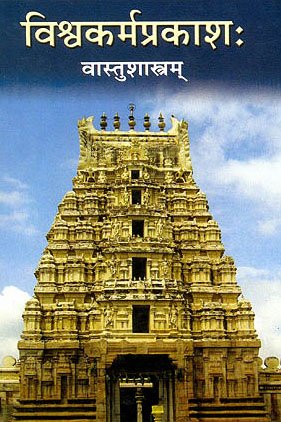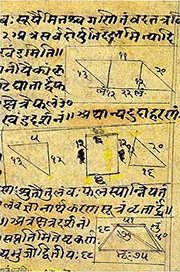Kamika, Kāmīka: 18 definitions
Introduction:
Kamika means something in Buddhism, Pali, Hinduism, Sanskrit, Marathi. If you want to know the exact meaning, history, etymology or English translation of this term then check out the descriptions on this page. Add your comment or reference to a book if you want to contribute to this summary article.
In Hinduism
Shaivism (Shaiva philosophy)
Source: Shodhganga: Iconographical representations of ŚivaKāmika (कामिक) or Kāmikāgama refers to one of the twenty-eight Siddhāntāgama: a classification of the Śaiva division of Śaivāgamas. The Śaivāgamas represent the wisdom that has come down from lord Śiva, received by Pārvatī and accepted by Viṣṇu. The Śaivāgamas are divided into four groups viz. Śaiva, Pāśupata, Soma and Lākula. Śaiva is further divided in to Dakṣiṇa, Vāma and Siddhānta (e.g., kāmika).

Shaiva (शैव, śaiva) or Shaivism (śaivism) represents a tradition of Hinduism worshiping Shiva as the supreme being. Closely related to Shaktism, Shaiva literature includes a range of scriptures, including Tantras, while the root of this tradition may be traced back to the ancient Vedas.
Purana and Itihasa (epic history)
Source: Shodhganga: The saurapurana - a critical studyKāmika (कामिक) the name of an ancient forest, according to the 10th century Saurapurāṇa: one of the various Upapurāṇas depicting Śaivism.—Accordingly, Sūta said that once Manu, the son of Sūrya went to a forest named Kāmika, where the sages Bhṛgu and others were trying to determine the highest truth on the occasion of a great sacrifice instituted by king Pratardana. Being unable to come to a conclusion the sages went with Manu to Dvādaśāditya, the land of the Sun and practiced penance there for thousand years. The Sun was pleased and appeared before Manu, who then eulogised him...

The Purana (पुराण, purāṇas) refers to Sanskrit literature preserving ancient India’s vast cultural history, including historical legends, religious ceremonies, various arts and sciences. The eighteen mahapuranas total over 400,000 shlokas (metrical couplets) and date to at least several centuries BCE.
Shaktism (Shakta philosophy)
Source: Google Books: ManthanabhairavatantramKāmikā (कामिका) or Bhūtabhāvanā refers to the Secret Language (bhāṣā, choma) associated with Avyakta, one of the eight Sacred Seats (pīṭha), according to the Yogakhaṇḍa (chapter 14) of the Manthānabhairavatantra, a vast sprawling work that belongs to a corpus of Tantric texts concerned with the worship of the goddess Kubjikā.

Shakta (शाक्त, śākta) or Shaktism (śāktism) represents a tradition of Hinduism where the Goddess (Devi) is revered and worshipped. Shakta literature includes a range of scriptures, including various Agamas and Tantras, although its roots may be traced back to the Vedas.
Vastushastra (architecture)
Source: Brill: Śaivism and the Tantric Traditions (architecture)Kāmika (कामिक) refers to “desire”, according to the Devyāmata (chapter 105).—Accordingly, [while describing the consequences of a doorway]—“[...] The fourth one, named Māhendra, fulfills every desire for the householder (sarva-kāmika). The fourth one in the house facing south, Gṛhakṣata, increases food, drink and sons for householders. The sixth one, called Gandhārva, brings glory, pleasures and contentment. [...]

Vastushastra (वास्तुशास्त्र, vāstuśāstra) refers to the ancient Indian science (shastra) of architecture (vastu), dealing with topics such architecture, sculpture, town-building, fort building and various other constructions. Vastu also deals with the philosophy of the architectural relation with the cosmic universe.
Ganitashastra (Mathematics and Algebra)
Source: archive.org: Hindu MathematicsKāmika (कामिक) refers to the “unknown quantity” (lit. “any desired quantity”), according to the principles of Bījagaṇita (“algebra” or ‘science of calculation’), according to Gaṇita-śāstra, ancient Indian mathematics and astronomy.—The unknown quantity was called in the Sthānāṅga-sūtra (before 300 B.C.) yāvattāvat (as many as or so much as, meaning an arbitrary quantity). In the so-called Bakhshali treatise, it was called yadṛcchā, vāñchā or kāmika (any desired quantity). This term was originally connected with the Rule of False Position.

Ganitashastra (शिल्पशास्त्र, gaṇitaśāstra) refers to the ancient Indian science of mathematics, algebra, number theory, arithmetic, etc. Closely allied with astronomy, both were commonly taught and studied in universities, even since the 1st millennium BCE. Ganita-shastra also includes ritualistic math-books such as the Shulba-sutras.
In Buddhism
Tibetan Buddhism (Vajrayana or tantric Buddhism)
Source: BDK Tripiṭaka: The Susiddhikara-sūtraKāmika (कामिक) refers to “desirable food”, as mentioned in Chapter 12 (“offering food”) of the Susiddhikara-sūtra. Accordingly, “If among the oblation rites you see one that uses ‘kāmika (desirable) food,’ you should offer svastika cakes, ulopika (?) cakes, and other dishes prepared to the best of your ability: these include [dishes with] granular sugar, boiled rice mixed with curds, roots, fruits, and milk gruel. This kāmika food is suitable for offering in all instances except ābhicāruka [rites]. If among the oblation rites you see one that uses ‘vicitra (variegated) food,’ add to the kāmika food two or three kinds of food different from the above: this is [vicitra food]. If among the oblation rites you see one that uses ‘udāra (great) food,’ double the above kāmika food and set out large quantities: this is [udāra food]”.

Tibetan Buddhism includes schools such as Nyingma, Kadampa, Kagyu and Gelug. Their primary canon of literature is divided in two broad categories: The Kangyur, which consists of Buddha’s words, and the Tengyur, which includes commentaries from various sources. Esotericism and tantra techniques (vajrayāna) are collected indepently.
Languages of India and abroad
Marathi-English dictionary
Source: DDSA: The Molesworth Marathi and English Dictionarykāmīka (कामीक).—a R kāmīṭa a R (kāma) Busy, diligent, industrious, laborious.
Source: DDSA: The Aryabhusan school dictionary, Marathi-Englishkāmika (कामिक).—a Lustful, amorous. Desirous.
Marathi is an Indo-European language having over 70 million native speakers people in (predominantly) Maharashtra India. Marathi, like many other Indo-Aryan languages, evolved from early forms of Prakrit, which itself is a subset of Sanskrit, one of the most ancient languages of the world.
Sanskrit dictionary
Source: DDSA: The practical Sanskrit-English dictionaryKāmika (कामिक).—a. Desired, wished for.
-kaḥ A wild duck.
Source: Cologne Digital Sanskrit Dictionaries: Shabda-Sagara Sanskrit-English DictionaryKāmika (कामिक).—m.
(-kaḥ) A kind of wild duck. E. kan added to the preceding.
Source: Cologne Digital Sanskrit Dictionaries: Benfey Sanskrit-English DictionaryKāmika (कामिक).—i. e. kāma + ika, I. adj., f. kī. 1. Wished, wish, Mahābhārata 13, 6025. 2. Wishing, 1969. 3. In sarvakāmika the aff. ika belongs to the comp. sarva-kāma, Attaining all one’s desires, Mahābhārata 3, 13860.
Source: Cologne Digital Sanskrit Dictionaries: Cappeller Sanskrit-English DictionaryKāmika (कामिक).—[adjective] desired, wished for.
Source: Cologne Digital Sanskrit Dictionaries: Monier-Williams Sanskrit-English Dictionary1) Kāmika (कामिक):—[from kāma] mfn. desired, wished for, [Mahābhārata xiii, 6025]
2) [v.s. ...] satisfying desires, [Mahābhārata iii, 13860]
3) [v.s. ...] (ifc.) relating to or connected with a desire or wish
4) [v.s. ...] m. a wild duck (kāraṇḍava), [cf. Lexicographers, esp. such as amarasiṃha, halāyudha, hemacandra, etc.]
5) [v.s. ...] Name of an author of Mantras
6) Kāmikā (कामिका):—[from kāmika > kāma] f. a mystical Name of the letter t
7) Kāmika (कामिक):—[from kāma] n. Name of [work] [Hemādri’s Caturvarga-cintāmaṇi]
Source: Cologne Digital Sanskrit Dictionaries: Yates Sanskrit-English DictionaryKāmika (कामिक):—(kaḥ) 1. m. A wild duck.
Source: DDSA: Paia-sadda-mahannavo; a comprehensive Prakrit Hindi dictionary (S)Kāmika (कामिक) in the Sanskrit language is related to the Prakrit words: Kāmia, Kāmiā.
[Sanskrit to German]
Sanskrit, also spelled संस्कृतम् (saṃskṛtam), is an ancient language of India commonly seen as the grandmother of the Indo-European language family (even English!). Closely allied with Prakrit and Pali, Sanskrit is more exhaustive in both grammar and terms and has the most extensive collection of literature in the world, greatly surpassing its sister-languages Greek and Latin.
Kannada-English dictionary
Source: Alar: Kannada-English corpusKāmika (ಕಾಮಿಕ):—[adjective] that is desired, wished or yearned for.
--- OR ---
Kāmika (ಕಾಮಿಕ):—
1) [noun] = ಕಾಮಿಕಾಗಮ [kamikagama].
2) [noun] a kind of duck.
Kannada is a Dravidian language (as opposed to the Indo-European language family) mainly spoken in the southwestern region of India.
See also (Relevant definitions)
Starts with: Kamikagama, Kamikam, Kamikamajori, Kamikatantra, Kamikavrata.
Ends with: Abhikamika, Akamika, Akkamika, Cankamika, Girikamika, Mahakamika, Opakkamika, Putrakamika, Sarvakamika, Sarvvakamika.
Full-text (+238): Kamia, Sarvakamika, Kamikam, Kamikagama, Kamuka, Putrakamika, Abhigamika, Bhutabhavana, Vicitra, Udara, Agama, Tantra, Uttarabhaga, Vatulatantra, Purvabhaga, Gopurasthapana, Anugrahapratishtha, Gotranirnaya, Bhaktanugraha, Parivara.
Relevant text
Search found 22 books and stories containing Kamika, Kāmīka, Kāmika, Kāmikā; (plurals include: Kamikas, Kāmīkas, Kāmikas, Kāmikās). You can also click to the full overview containing English textual excerpts. Below are direct links for the most relevant articles:
The Padma Purana (by N.A. Deshpande)
Chapter 54 - Kāmikā Ekādaśī < [Section 6 - Uttara-Khaṇḍa (Concluding Section)]
Chapter 53 - Devaśayanī Ekādaśī < [Section 6 - Uttara-Khaṇḍa (Concluding Section)]
Temples of Munnur (Historical Study) (by R. Muthuraman)
Introduction: Pujas and Festivals < [Chapter 6]
Sivaprakasam (Study in Bondage and Liberation) (by N. Veerappan)
Works by Earlier Shaiva Siddhanta Teachers < [Chapter 1 - Introduction]
Shaiva Upanishads (A Critical Study) (by Arpita Chakraborty)
12. Revelation of Āgamās on the forms Pañcabrahman < [Chapter 5 - Essence of Pañcabrahma Upaniṣad]
Kashyapa Shilpa-shastra (study) (by K. Vidyuta)
5. Problem faced in Understanding the text Kāśyapa Śilpaśāstra < [Chapter 6 - Conclusion]
5.2. Classification of the Āgamas < [Chapter 1 - Introduction]
Vastu-shastra (1): Canons of Architecture (by D. N. Shukla)
(v) Vāstu literature (Introduction) < [Chapter 4 - An outline History of Hindu Architecture]
(v,6-7) Vāstu in the Āgamas and Tantras < [Chapter 4 - An outline History of Hindu Architecture]
(iii) Proportionate measurements (Māna, Aṅgula, Hasta) < [Chapter 6 - Fundamental Canons of Hindu Architecture]